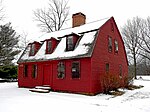Elmore Houses
Colonial architecture in the United StatesGreek Revival architecture in ConnecticutHouses completed in 1843Houses in Hartford County, ConnecticutHouses on the National Register of Historic Places in Connecticut ... and 2 more
National Register of Historic Places in Hartford County, ConnecticutSouth Windsor, Connecticut

The Elmore Houses are a pair of historic farmhouses at 78 and 87 Long Hill Road in South Windsor, Connecticut. The two houses, one built before 1819 and restyled in the 1840s, and the other one built new in the 1840s, are locally important rural examples of Greek Revival architecture. They were listed on the National Register of Historic Places in 1985.
Excerpt from the Wikipedia article Elmore Houses (License: CC BY-SA 3.0, Authors, Images).Elmore Houses
Long Hill Road,
Geographical coordinates (GPS) Address Nearby Places Show on map
Geographical coordinates (GPS)
| Latitude | Longitude |
|---|---|
| N 41.802777777778 ° | E -72.595 ° |
Address
Long Hill Road 87
06074
United States
Open on Google Maps










